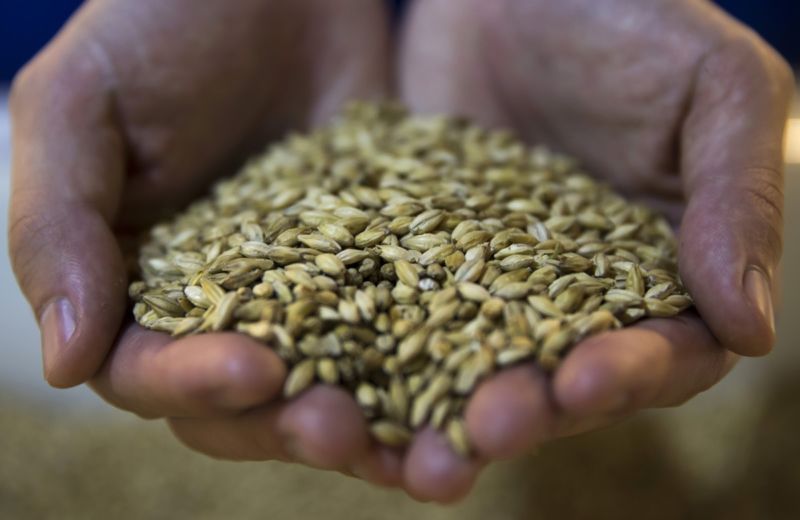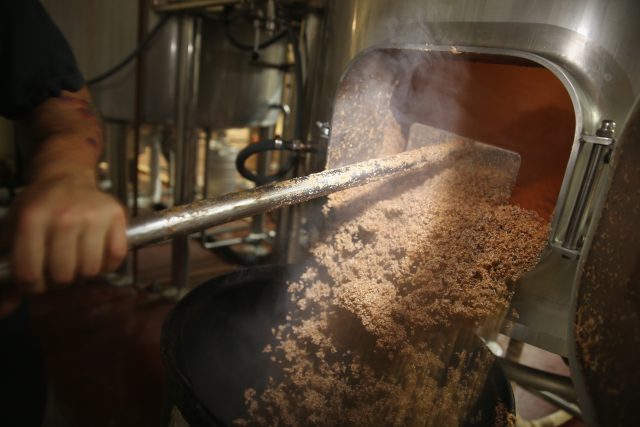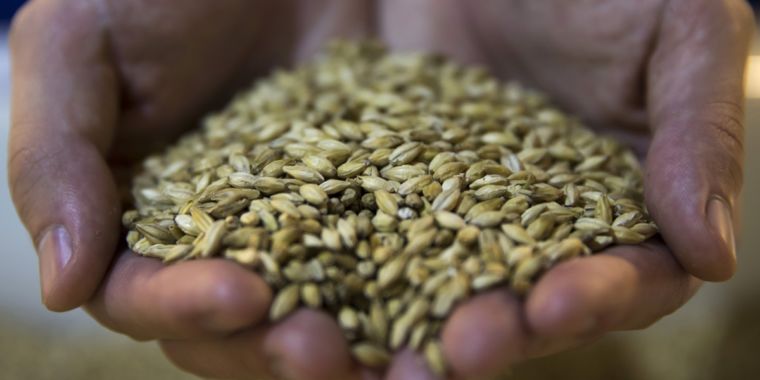

Tomohiro Ohsumi/Bloomberg/Getty Images
There’s nothing quite like putting your feet up after a long, hot summer day and enjoying a refreshing cold brew if you’re a beer lover. But a warming climate could give rise to global barley shortages, with a resulting shortage of beer. That’s the conclusion of a new study just published in Nature Plants.
Beer brewers account for roughly 17 percent of the barley consumption worldwide, although it varies from region to region, with the vast majority of crops harvested as feed for livestock. If barley becomes too scarce, more of it will be funneled to livestock, since beer is technically a luxury good. The shortage of barley will give rise to steep price hikes and corresponding decreases in global consumption. While the most affluent beer lovers will still be able to indulge in a pint or two, “Future climate and pricing conditions could put beer out of reach for hundreds of millions of people around the world,” says study co-author Steven Davis of the University of California, Irvine.
Davis himself is a beer aficionado and home brewer, who frequently travels to China for research collaborations. During one such trip a couple of years ago, he spoke with a scientist at the Chinese Agricultural Academy of Sciences, who was studying the global supply of beer. (China is currently the largest consumer of beer and thus would be hit hard by a severe barley shortage.) They decided to collaborate on a study investigating the impact of climate change on beer, partnering with other researchers in the United Kingdom and Mexico.
Mad for mash
Brewers start the process by exposing grain to moisture so that it germinates, converting the starches into sugars. When the sugar levels are just right, they roast the grains, resulting in a malt for kicking off the fermentation into beer. In principle, any grain can be malted: wheat, rye, corn, and rice. But for beer, barley is the undisputed king, because it germinates quickly and has a rich flavor when roasted. While brewers occasionally experiment with adding rice or wheat to their brews, “That’s usually frowned upon as padding,” says Davis. “The purists want you to use barley,” Even wheat beers are still mostly barley.
Barley farmers in Montana are already feeling the impact of a warmer climate, although they are more likely to talk publicly about “erratic weather” or “drier, hotter summers” in that Republican stronghold, rather than the politically charged “climate change.” They are struggling to grow barley crops in more frequently occurring conditions of severe drought and extreme heat. Hot, dry weather compromises grain quality, making it more likely the barley will be sold as feed, at one-third the asking price of barley sold for beer. And climate scientists predict it will only get worse for the region, with statewide temperatures rising 4° to 5° Fahrenheit by 2055.

/ No barley, no beer: A beer brewer pulls malted barley from the mash tun at Wynwood Brewing Company in Miami, Florida.
Joe Raedle/Getty Images
Barley is a fairly temperate crop, predominantly grown in cooler regions like the Northern Great Plains, North Central Europe, Australia, and the Asian steppe. So it’s likely that barley farmers can adapt to gradual changes in the climate—at least that’s the “somewhat heroic assumption” Davis et al. made in their study. Farmers could selectively breed their crops, or tweak them genetically, to develop more drought-resistant barley, for instance. They could also change their farming practices to increase yields in warmer conditions.
That’s why the researchers focused on the most extreme years for their study, with shifts so severe that it’s unlikely farmers would be able to adapt fast enough. According to Davis, under the most-favorable scenario they modeled, where the world avoids two degrees of warming (an increasingly unlikely scenario), roughly ten percent of those years will be extreme by the end of the 21st century. Under the worst-case scenario, it will be roughly every other year. Extreme heat and drought would “pretty much become the norm,” he says.
To the extreme
The researchers took those extreme climate events and modeled their impact on barley yields in 23 world regions. Then they studied the effect of the resulting barley shortages on the supply and price of beer in each region, under several different scenarios. They concluded that the largest barley growing regions would experience declines in crop yields of 3 to 17 percent, depending on the severity of the conditions. Beer prices would double on average, and consumption would decrease by between 4 percent and 16 percent in the best and worst case scenarios, respectively.
Naturally, there would be regional variations. Price swings are tied to the ability and willingness of consumers to pay more for beer, or, alternatively, to drink less of it, thereby decreasing consumption, per Davis. Beer is already expensive in Australia and Japan, for instance, so beer drinkers there wouldn’t feel the brunt of the sticker shock quite so much as other regions, like Belgium, Germany, or the Czech Republic. In Ireland, Davis estimates that people could pay an extra $20 per six pack.
“Not having a cool pint at the end of an increasingly common hot day just adds insult to injury.”
It’s difficult to say whether barley shortages will affect craft brewers or big commercial brewers like Coors more, according to Davis. One could argue that fans of craft beers already are sufficiently affluent to afford more expensive beers, and thus might be more willing to pay even higher prices during a shortage. Coors’ customers might be less willing. Then again, Coors has the market dominance to be able to get good barley even in shortage years, with large enough profit margins to ride out the lean times.
A shortage of beer might not strike you as the most pressing life-or-death impact of global climate change, given the rising sea levels, stronger hurricanes, and worsening wildfires that have been making headlines of late. But most people rarely stop to consider all the little ways a warmer climate will impact their day-to-day lives.
“In an affluent country like the United States, people might not be so concerned if their bread gets 10 to 25 cents more expensive,” says Davis. “It could be that luxury goods are actually more visible, in terms of the impact of climate change on affluent consumers. There is definitely a cross-cultural appeal to beer, and not having a cool pint at the end of an increasingly common hot day just adds insult to injury.”
DOI: Nature Plants, 2018. 10.1038/s41477-018-0263-1 (About DOIs).








